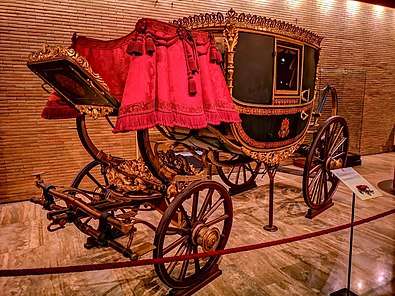Hammercloth
A hammercloth is a large decorative piece of fabric, often fringed and richly adorned with embroidery, gemstones, and cloth of gold, placed over and around the seat of the coachman of a traditional horse and carriage. A hanmercloth might display a family crest or other emblems of the heritage of the passenger within the coach.

Origin
The origin of the word hammercloth is uncertain, and several etymologies have been given. One is that a coachman used to carry his tools, including a hammer, with him underneath his seat to perform repairs to a carriage should it break down on the road. Another is that the "hammer" portion is a corruption of the word "hamper", and meant to suggest that the cloth covered a hamper which might contain food for the passengers or coachman. A third is that it is a corruption of "hammock", and that a "hammock-cloth" was a strip of fabric used instead of a wooden seat in days before carriages had springs for shock absorption. On a carriage with no springs, a hammock provides a much more comfortable ride than a wooden slat, and so "hammock-cloth" may have been the original term.[1][2]
References
- "What is the origin of Hammer-cloths?". Replies: A weekly journal of question and answer. II (35): 138. 29 November 1879. Retrieved 15 December 2019.
- Samuel Pegge (1818). Curialia Miscellanea; Or, Anecdotes of Old Times: Regal, Noble, Gentilitial, and Miscellaneous: Including Authentic Anecdotes of the Royal Household, and the Manners and Customs of the Court, at an Early Period of the English History. J. Nichols, Son, and Bentley. p. 304.